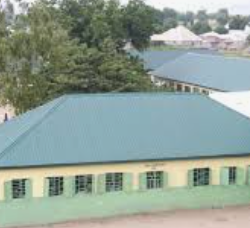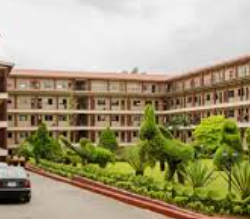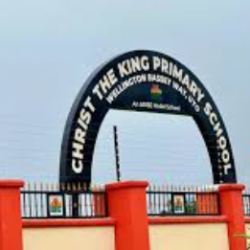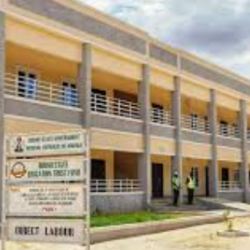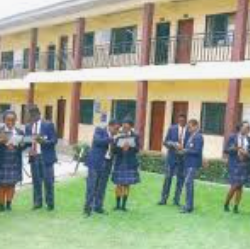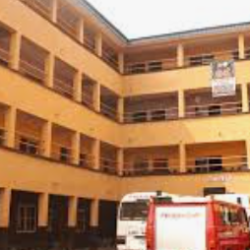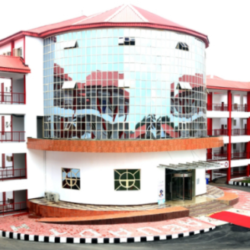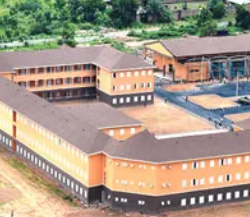Bayero University is an institution of higher learning in Kano, Nigeria. The university (as of 2024) had 43,027 students, 1,693 academic staff, 94 departments, 18 faculties and 5 campuses.
It started in January 1960 when Ahmadu Bello College was established and located at the school for Arabic Studies (close to the palace of the Emir of Kano).

Basics
- 43,027 Student Enrollment
- 1,693 Academic Staff
- 2,898 Non-Teaching Staff
- 94 Departments
- 124 Undergraduate Programmes
- 264 Postgraduate Programmes
- 5 Campuses
- 18 Faculties
- 16 Centres
- 4 Schools
- 2 Colleges
- 1 Institutes
Colleges
- College Of Health Science
- College Of Natural And -Pharmaceutical Science
Faculties
- Arts And Islamic Studies
- Agriculture
- Computer Science and Information Technology
- Communication
- Engineering
- Earth And Environmental
- Education
- Law
- Management Sciences
- Social Sciences
- Veterinary Medicine
Centres
- Advanced Medical Research
- African And Entrepreneurship Research
- Biotechnology Research
- Democratic Research & Training
- Dryland Agriculture
- Gender Studies
- Excellence For Population Health Policy
- Economic, Social And Population Research
- Information Technology
- Infectious Disease
- Islamic Civilization And Interfaith Dialogue
- Nigeria Center For Reading Research And Development
- Research In Nigerian Languages, Translation & Folklore
- Quranic Studies
- Renewable Energy
Institutes
- Islamic Banking & Finance School
- Postgraduate Studies
- Dangote Business School
- School Of Continuing Education
- School Of General And Entrepreneurship Studies
Contact
PMB 3011, Gwarzo Road Kano, Nigeria.
Telephone: (+234) 816- 0107510
E-mails: registrar@buk.edu.ng, bukinfo@buk.edu.ng
History
In October 1962 the first University to be established in Northern Nigeria, Ahmadu Bello University, was founded in Zaria and this made a change of name for the Ahmadu Bello College in Kano necessary to avoid any confusion. In the same year, the Ahmadu Bello College was renamed Abdullahi Bayero college after the Emir of Kano, Abdullahi Bayero (Abdullahi Bayero had ruled Kano from 1927 to 1953).

In January, 1964 the College moved to a temporary site at the old Kano Airport Hotel with its first set of students admitted for a B.A. degree programme of Ahmadu Bello University. They started their lectures on 1st February 1964. The College also acquired its first Provost at this time, Professor Abdullahi el-Tayyeb, a Sudanese. Abdullahi Bayero College (ABC/ABU) graduated its first set of students in July 1966. There were 10 of them, and they convocated in November, 1966.
Since then the institution, which was a Faculty of Ahmadu Bello University, Zaria presented graduating students to Ahmadu Bello University, every year until 1980.
With the departure of Professor el-Tayyeb in 1966, Alhaji Hamidu Alkali was appointed as the second Provost and arrived in Kano in September, 1966. Alhaji Hamidu Alkali was appointed Provost and also Dean, Faculty Of Arts and Islamic Studies and remained in office to November, 1969. His years at ABC/ABU coincided with the Nigerian civil war years. But it was also a period of the development of the first phase of ABC’s permanent site (now called Old Campus, B.U.K).
At the time of the arrival of Alhaji Hamidu the Library complex which up to today 1999 is the main Library of the University, was at the foundation level. He supervised the building of the Library and the other buildings such as the first kitchen (Kitchen I), the first female hostel, accommodating forty students (now occupied by a branch of the United Bank for Africa), and a generator house. The funds came from the British Colonial Government grant for Higher Education in Nigeria when Nigeria was being prepared for independence.
When the civil war started in July, 1967 the ABC temporary site at the old Kano Airport Hotel (at the time it was the main Kano Airport) became a military target for the Biafran Airforce because of the location of some Russian-made MIG Fighters of the Federal Airforce in the vicinity of the old Airport. A home-made bomb was dropped around the area towards the end of 1967. The college was not affected. The civil war became intensified by the first quarter of 1968 and there were in Kano many wounded Federal soldiers from the war fronts.
At a very short notice, the ABC, through ABU Zaria was ordered by the military authorities to move out of the old Airport Hotel to give room for the facilities to be turned into a military hospital. Therefore Abdullahi Bayero College moved to its permanent site in March, 1968 and the Library complex was commissioned on 26th April, 1969 by the British High Commissioner in Nigeria, Sir David Hunt. The permanent site is located at the western outskirts of the Kano city walls in the vicinity of Kabuga and Dukawuya gates on Kano-Gwarzo Road.
It was also during this phase of the development of Abdullahi Bayero College that a maintenance unit of the ABU Estate Department was established to look after not only the new buildings but also the senior staff houses, AB1 to AB20, had been constructed between 1959 and 1961 by the Northern Nigerian Government as part of the extension of Kano Nassarawa Government Reservation Area. The fencing of the College land area of about 600 acres was started. Alhaji Hamidu Alkali was moved to ABU Zaria in November, 1969 as Director, Institute Of Education. He was succeeded by Dr. S.A.S. Galadanci, who held the post until he was appointed as the Vice-Chancellor of the University of Sokoto in 1975.
Abdullahi Bayero College entered its second phase of development during the tenure of Professor S.A.S Galadanci. The buildings to house the Faculties of Arts and Islamic studies and Education were built. Likewise, the first male student hostel together with a larger female student hostel were constructed. The Kano State Government under the late Governor Audu Bako contributed a lot towards the physical development of the College especially in the area of hostel accommodation.
In 1975 the Abdullahi Bayero College was raised to the status of a University College with the right to award degrees on behalf of Ahmadu Bello university. The institution adopted the new name of Bayero University College and its first Principal was Dr. Mahmud Tukur, who formally took over in September, 1975. The University College also got a separate Governing Council headed by Professor S.O. Biobaku.
In 1977 the Federal Government of Nigeria made all the University Colleges in the country full-fledged universities. Thus Bayero University College dropped ‘Abdullahi’ and ‘College’ and became simply Bayero University. The Principal of the College, Dr. Mahmud Tukur, therefore became the first Vice-Chancellor Of Bayero University.
Dr. Mahmud Tukur together with a dedicated team shouldered the responsibility of establishing the foundation of a University. The philosophy, orientation, and mission of the University were clearly spelt out.
The first phase of the development of Bayero University was vigorously undertaken during the time of Dr. Mahmud’s administration. He clearly established the norms, procedures and structure for the Faculties of Social and Management Sciences, Science, Technology and Law. The Department of Mass Communications and the School of General Studies also took off. The Estate Department, together with the Physical Planning Unit, were also established. More importantly, the development of the new permanent site of the University took off in earnest. A ten-thousand acre piece of land, five kilometres out of Kano on the Kano-Gwarzo Road was acquired. The difficult and sensitive task of demarcating the farm lands and computing compensation and payment to the right people were all carried out.
In October 1977, Dr. Mahmud Tukur left Bayero University and was succeeded in 1978 by Professor J.O.C. Ezeilo, who was transferred from the University of Nigeria, Nsukka. Professor Ezeilo spent the remaining one year of his full term as Vice-Chancellor of University of Nigeria, Nsukka at Bayero.
Professor Ezeilo was succeed by Professor I.H. Umar (1979-1986). Professor I.H. Umar handled the second phase of the development of the permanent site of Bayero University. By 1986, the core buildings of the new site of the University had been completed. These include the academic and administrative buildings, the student hostels, junior and senior staff quarters, the access roads, and the Business Centre. The Library building also reached advanced stage. However, B.U.K’s movement to the site did not take place until the period of the successor of Professor Umar, Professor Dandatti Abdulkadir (1986-1990).
Professor Dandatti’s tenure saw the movement of the University to its permanent site (called the New Site). The Vice-Chancellor also moved into the new Vice-chancellor’s Lodge on the New Site. A large number of students also moved into the new hostels. This ushered in the system of commuting between the new and old campuses of the University, which both students and lecturers had to adopt.
The Old Campus is now occupied by the Faculties of Science, Medicine and Law. The School of General Studies and the Centre for the Study of Nigerian Languages are also located on the Old Campus. Professor Dandatti was succeeded in 1990 by Professor M. S. Zahraddeen. In 1995, Professor B. B Dambatta took over as the Vice-Chancellor and in 1999 he was succeeded by Professor Musa Abdullahi. Professor Attahiru Mahmud Jega is now the current Vice-Chancellor.
In October 1964 the first Faculty of what later became Bayero University, the Faculty of Arabic and Islamic Studies, was established. The Faculty was renamed the Faculty of Arts and Islamic Studies in November, 1966. The Faculty consisted of the Department of Arabic, Islamic studies, History, English and European Languages, Nigerian Languages and Education. In October 1976, two new Faculties were established, namely: Education, and the School of Management Sciences which was renamed Social and Management Sciences in 1977.
In 1994 the Bayero University had seven Faculties, namely:
- Faculty of Arts and Islamic Studies
- Faculty of Education
- Faculty of Social and Management Sciences
- Faculty of Science (1975)
- Faculty of Law (1977-78)
- Faculty of Technology (1977-78) and
- Faculty of Medicine (1984-85)
Bayero University also has a School of General Studies and a Centre for the Study of Nigerian Languages (CSNL). The Centre is a research unit established in 1969 as a Centre for Hausa Studies with the aid of a two thousand pound (£2,000.00) grant from the Kano State Government. It subsequently received grants from the former North Western and North Central State Governments as well as donations from individuals like the late Mallam Aminu Kano and the late Ambassador Muhammadu Sani Kontagora. The School of General Studies provided pre-degree courses to students to enable them qualify for various degree courses. This was been discontinued with the introduction of the 4-year degree system in 1989-90. It is under the aegis of this school also that all undergraduates of the University take a course in General Studies, which is a national requirement for the award of a degree irrespective of the course an undergraduate is registered for. Diploma courses, begun by the Faculty of Arts and Islamic Studies, are now, readily offered in most of the Faculties of Bayero University.
